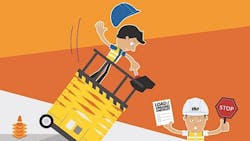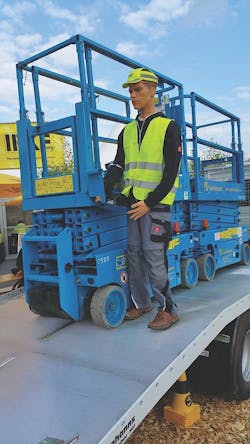Millions of deliveries or collections of aerial work platforms (AWPs), also known as mobile elevating work platforms (MEWPs), take place each year on sites across North America. Delivery drivers play a vital role. They are probably the only face and actual contact point between the rental company and the end-user on site. Any incident involving drivers during delivery and collection of an AWP/MEWP has the potential to be serious and could also affect contractor relations and site operations.
Recent data collected from IPAF rental company members has increased focus on the risks to delivery drivers. Since January 2012, all IPAF members are requested to report all AWP/MEWP-related incidents involving their own staff to the IPAF accident reporting database (www.ipaf.org/accident). Analysis of the recent data confirms some trends identified from previous years and highlights specific situations that involve a significant proportion of drivers.
A majority of the incidents (44.2 percent) took place on site, with another 25.7 percent occurring in the depot/yard, 13.6 percent occurring in the workshop and 11.2 percent occurring on the public roadway. The most common types of injury incurred were cuts and bruising of the upper limb, lower limb and head.
Most of the incidents involving delivery drivers occurred during loading and unloading (48.7 percent). The main causes of driver-related incidents were identified as insecure load and the machine falling off between ramps. Closer analysis of the incidents caused by insecure load revealed that these were mainly caused by the canopy becoming detached from the machine during transport. Almost all the machines that fell off between ramps were small electric units (mobile verticals, 3a).
Most of the incidents involving mechanics occurred during maintenance (66.7 percent). The main causes of these mechanic-related incidents were identified as using hand tools and slips/trips. Closer analysis of the incidents caused by using hand tools revealed that these were caused by using hammers. Almost half of the slips/trips happened while walking.
Most of the incidents involving operators occurred when the AWP/MEWP was being operated from the platform controls (51.2 percent). The main cause of these operator-related incidents was identified as lack of observation and failure to check the route, i.e. colliding with stationary objects while driving on unfamiliar sites.
The data clearly shows that loading and unloading AWPs/MEWPs can be hazardous. Yet they are the safest way of doing temporary work at height. There are few accidents, and you can make the number even lower. Have you planned for safe operations?
- Ensure that a senior manager is responsible for planning AWP/MEWP deliveries, collection and transportation.
- Perform a proper risk assessment for all AWP/MEWP operations and document this process.
- Ensure that all employees are adequately trained to fulfil their responsibilities.
Know your responsibilities – play your part in preventing accidents! (Table showing roles of contractor, rental company, transporter, driver.)
Top four hazards and how to avoid them
- Potential danger 1: Foot run over
When driving an aerial work platform with the upper control box detached, keep a safe distance and use smooth driver or steer movements. Know and watch where the machine is going.
- Potential danger 2: Trapped between machines
Do not stand in between machines – it could be fatal! Never assume you know which direction the AWP/MEWP will travel – always check by driving slowly to start. Concentrate on what you are doing and stop if you get distracted.
- Potential danger 3: Falling while driving down ramps
Drive the AWP/MEWP slowly and carefully. Use the winch to prevent runaway. Avoid adjusting steering on the ramps. Use a vehicle with a full width ramp. Never drive on or off a ramp at an angle. Always approach the ramp with the AWP/MEWP aligned straight. Watch out for slips and trips.
- Potential danger 4: Catapult effect
Loading and unloading of booms also presents significant risk of ejection. Make sure you wear your harness with a short lanyard and fasten on at all times.
More resources on safe loading and unloading are at www.ipaf.org/load.
• Loading/unloading of AWPs/MEWPs
• AWPs/MEWPs for Managers
• Operator
• Demonstrator
New guidance
IPAF working groups have produced good practice guides relating to drivers and the management of safe loading and unloading of AWPs/MEWPs:
• Guidance to identify the responsibilities of contractors, rental companies, transporters and drivers when planning and carrying out loading/unloading activities
• Guidance for loading and unloading AWPs/MEWPs on the public roadway
This article was contributed by IPAF, the International Powered Access Federation.
SaveSave
SaveSave


